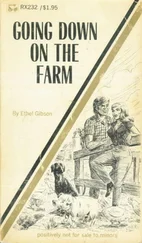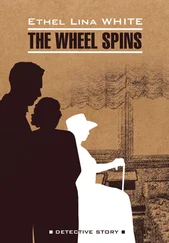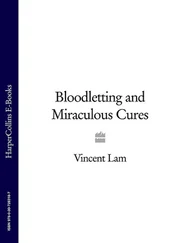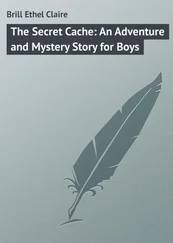Ethel Vincent - Newfoundland to Cochin China
Здесь есть возможность читать онлайн «Ethel Vincent - Newfoundland to Cochin China» — ознакомительный отрывок электронной книги совершенно бесплатно, а после прочтения отрывка купить полную версию. В некоторых случаях можно слушать аудио, скачать через торрент в формате fb2 и присутствует краткое содержание. Жанр: Путешествия и география, foreign_antique, foreign_prose, на английском языке. Описание произведения, (предисловие) а так же отзывы посетителей доступны на портале библиотеки ЛибКат.
- Название:Newfoundland to Cochin China
- Автор:
- Жанр:
- Год:неизвестен
- ISBN:нет данных
- Рейтинг книги:5 / 5. Голосов: 1
-
Избранное:Добавить в избранное
- Отзывы:
-
Ваша оценка:
- 100
- 1
- 2
- 3
- 4
- 5
Newfoundland to Cochin China: краткое содержание, описание и аннотация
Предлагаем к чтению аннотацию, описание, краткое содержание или предисловие (зависит от того, что написал сам автор книги «Newfoundland to Cochin China»). Если вы не нашли необходимую информацию о книге — напишите в комментариях, мы постараемся отыскать её.
Newfoundland to Cochin China — читать онлайн ознакомительный отрывок
Ниже представлен текст книги, разбитый по страницам. Система сохранения места последней прочитанной страницы, позволяет с удобством читать онлайн бесплатно книгу «Newfoundland to Cochin China», без необходимости каждый раз заново искать на чём Вы остановились. Поставьте закладку, и сможете в любой момент перейти на страницу, на которой закончили чтение.
Интервал:
Закладка:
In 1872, Winnipeg, with a sudden awakening, realized the immense future before her as the capital of the Far West. Land was quickly bought up. Large prices given and realized. Houses were built on a magnificent scale. Crowds flocked in from all parts of Canada to share in the coming prosperity, A complete collapse followed. The bubble had burst.
The meaning of a "boom" may be thus simply exemplified. A buys a piece of land from B, and pays half the price down as a first instalment. He sells to C at an increased price, who, in his turn, does ditto to D. At length B, the original seller, calls for payment. C and D are unable to meet the call, and are ruined in endeavouring to do so, and the land is thrown back on A, who is in the same position, and B has it thrown on his hands, and never having in the first place received full payment, is also ruined, for he has speculated with the money. All classes had taken part in this "wild land speculation," and all were involved in the collapse. Houses were closed (for they could not be sold, as there were no purchasers) or are only, as we now see them, partially lived in. Winnipeg is slowly recovering from this "boom," and with the youth and energy of a young city will renew her prosperity.
Passing the ruined gateway of the old Fort Garry, we appropriately come to the Hudson Bay Store. It is contained in a large block of buildings, and is a new departure in the trade once absorbed by that great and powerful fur-trading company. They first explored the country, owned it, and kept up friendly relations with the Indians. It was one of those great trading monopolies, owned by merchants, and which have done so much for the wealth and commerce of England. The Hudson Bay Company has accomplished in a minor degree for Canada, what the East India Company did for India. This shop may truly be called the Army and Navy stores of the West, for it contains everything from brocades and Paris mantles (which are bought by the squaws) furs, carpets, groceries, to Indian blankets, pipes and bead work. In this bead work the blending of colours is exquisite. At the last Louis Riel rebellion, the wholesale department outfitted and provisioned at twenty-four hours' notice, 600 soldiers for thirty days.
We then visited the tennis club. I am impressed with the immense utility of this popular game, which, if useful in England, performs a large social duty in all Canadian towns. It forms a mild daily excitement, and a meeting place for all, and is especially useful in a country where, with the impossibility of obtaining servants, entertaining is a difficult matter.
Canon O'Meara took us one morning to the outskirts of the city to see the cathedral. Lying out in the country and built of wood, it resembles a simple village church. The surrounding cemetery is full of handsome monuments, and here lie many victims of the boom. The most interesting monument is the granite sarcophagus, engraved with seven names, surrounded by laurel wreaths of the victims of the last rebellion. Their remains were brought back here to be buried, with an impressive public funeral.
We visited the Bishop of Rupert's Land in his adjoining house. He is Metropolitan of eight bishoprics, and has an enormous diocese reaching into the unexplored regions of the Mackenzie River. He has organized a college on the model of an English University, and which confers degrees.
Studying the working of the Church in Canada, one recognizes some arguments in favour of Disestablishment. In Canada there is no State endowment, and the clergy are supported by voluntary contributions. This money comes partly from pew rents, and is greatly assisted by the envelope system. By this method the parishioner covenants to give a certain sum a year for the maintenance of his church, by fixed weekly Sunday instalments. He is furnished with fifty-two envelopes, on which his name is printed, and these contributions are entered in a book. There appears to be no difficulty in raising funds by these means, particularly if the clergyman is popular. If he is unpopular, or his doctrines unacceptable or extreme, he suffers by the falling off of his income. This system, moreover, has the advantage of giving every man an interest in his church. A clergyman observed that several members of his congregation appeared at church for the first time on the establishment of this envelope system. "Oh, yes," they said, in response to his remark, "we have got some stock in this concern now."
It works particularly smoothly where the bishop, adapting himself to the needs of a new country, admits the principle that those who pay must choose. They require, however, a Clergy Discipline Act as much as we do.
Mr. Robinson took us in the afternoon for a drive across the prairie to Sir Donald Smith's model farm at Silver Heights, where there are three splendid specimens of the now extinct buffalo, some of the few left of those vast herds that used to roam the prairie. The farm takes its name from the adjoining wood of silver poplar trees.
C. visited the venerable French Archbishop Taché. He told him that he came out forty-six years ago, and that it took him then sixty-two days to travel from Montreal, what he can now perform in sixty-two hours. He showed the inkstand from which his uncle, the Premier of Quebec, Sir Etienne Taché, signed the Confederation Act of Canada.
Thursday, August 27th. —Before leaving Winnipeg Major Heward gave us an early inspection at the barracks of the Mounted Infantry. They are smart and well-mounted on brancho horses, reared in the west. We also inspected the chief of the three fire stations. They have a chemical steamer. In this the water is mixed with carbolic acid gas. Fire being supported by oxygen, the carbolic gas, when thrown on it, extinguishes the supply of oxygen, and with it the fire. The fire bell, in sounding, throws open the stable door and the horses trot out by themselves and place their necks under the suspended collar, which descends and is fastened by a patent bolt.
The west-bound trains all stop at Winnipeg for five hours to allow time for the colonists to visit the Railway and Dominion Land Offices, and to obtain information respecting selections of lands. The land in the North-West Provinces has now been surveyed and allotted thus for twenty-four miles each side of the line. In a township of thirty-six sections of 640 acres, or one square mile to each section, the Dominion retains roughly one half, whilst the C.P.R. retains the other. There are two sections reserved for school purposes, that the value of the land may make the schools free and self-supporting, two sections for the Hudson Bay Company, and the Canada North-West Land Company have bought others. The diagram on page 53 will show the division of sections.
The station was crowded with large parties of emigrants, as many settlers leave their families here, whilst choosing their sections further west. There are bundles of bedding, tin cooking utensils, with bird cages and babies in promiscuous heaps.
As we pass out of the station we see the enormous plant and rolling stock of the C.P.R., which has here its half-way depot between Montreal and Vancouver. They have twenty miles of sidings, which are now full of plant waiting to be pressed forward, to bring down the harvest to the coast.
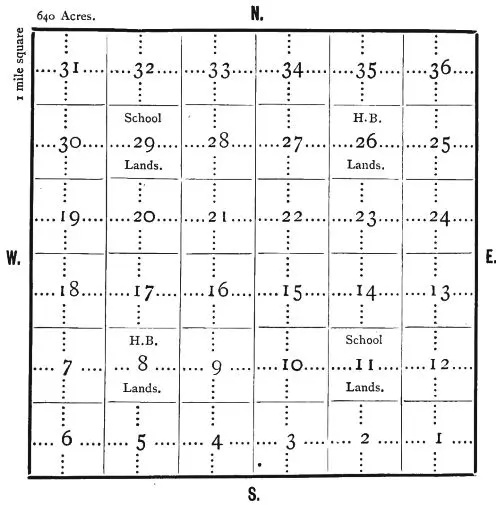
TOWNSHIP DIAGRAM.
The above diagram shows the manner in which the country is surveyed. It represents a township—that is, a tract of land six miles square, containing 36 sections of one mile square each. These sections are subdivided into quarter sections of 160 acres each.
We are out on the prairie at once, on that great billowy sea of brown and yellow grass; monotonous it is, and yet pleasing in its quiet, rich, monotones of colour. The virgin soil is of rich black loam. The belt of unsettled land round Winnipeg is caused by the land being held by speculators, but after that we pass many pleasant farms, clustering more thickly around Portage le Prairie, a rising town. We pass a freight train entirely composed of refrigerator cars, containing that bright pink salmon from British Columbia, which is a luxury in the east and a drug in the west. The engine bears a trophy of a sheaf of corn, to show that the harvest in the west has already begun.
Читать дальшеИнтервал:
Закладка:
Похожие книги на «Newfoundland to Cochin China»
Представляем Вашему вниманию похожие книги на «Newfoundland to Cochin China» списком для выбора. Мы отобрали схожую по названию и смыслу литературу в надежде предоставить читателям больше вариантов отыскать новые, интересные, ещё непрочитанные произведения.
Обсуждение, отзывы о книге «Newfoundland to Cochin China» и просто собственные мнения читателей. Оставьте ваши комментарии, напишите, что Вы думаете о произведении, его смысле или главных героях. Укажите что конкретно понравилось, а что нет, и почему Вы так считаете.


